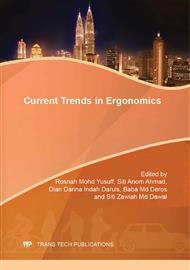p.278
p.287
p.293
p.300
p.308
p.313
p.318
p.327
p.331
Investigation on Working Postures and Musculoskeletal Disorders among Office Workers in Putrajaya
Abstract:
The cross-sectional study was conducted amongst thirty eight government supporting staff who mainly doing sedentary task in Malaysia Maritime Enforcement Affair Division (MMEAD) (49%) and Ministry of Health (MOH) (51%) in Putrajaya. The investigation aims to determine the association between working postures and musculoskeletal disorders (MSD) among office workers where all respondents were selected in 5 sections; administrative (64%), financial (12%), counter/assistant (12%), human resources management (6%) and procurement section (6%). Self-reported questionnaires using Nordic questionnaire were used in this investigation. Besides, posture analysis was done based on Rapid Upper Limb Assessment (RULA) and office ergonomics checklist adapted from Texas Department of Insurance, Division of Workers Compensation (2008) were used as the instrumentations of this investigation. Face validity and reliability testing for the questionnaire and intra tester reliability for the posture assessment was done to ensure true quality of the results and analysis. From the analysis, the highest prevalence of MSD complained is lower back pain (LBP) 57.9% while the lowest prevalence is elbow pain (EP) 2.6%. Result shows 31.6% of the respondents believe the pain is caused by working activities. Based on the ergonomics checklist, MMEAD shows the highest mean (64.84%) of non compliance, where all the workstations scored more than 50% compared with MOH. Based on RULA observation, most of the workstation scores in action level 3 (grand score 5-6). In conclusion, the high complained of MSD is due to awkward postures, unsuitable workstation and lack of knowledge related to the areas to apply in everyday routine and it shows that working postures have a direct contribution on MSD complained by the office workers in Putrajaya.
Info:
Periodical:
Pages:
308-312
Citation:
Online since:
December 2013
Permissions:
Share:
Citation:


